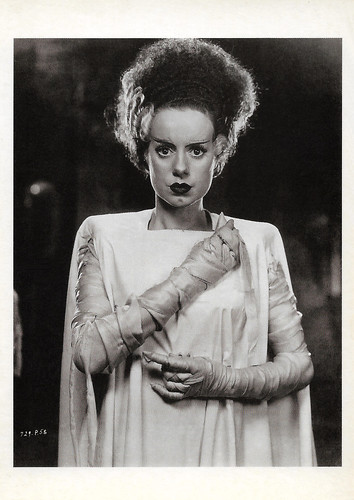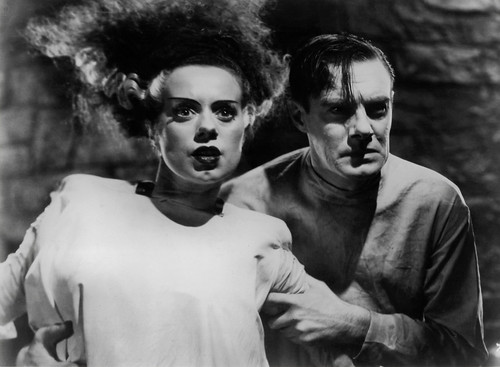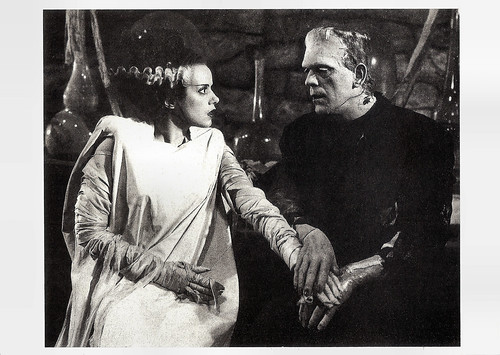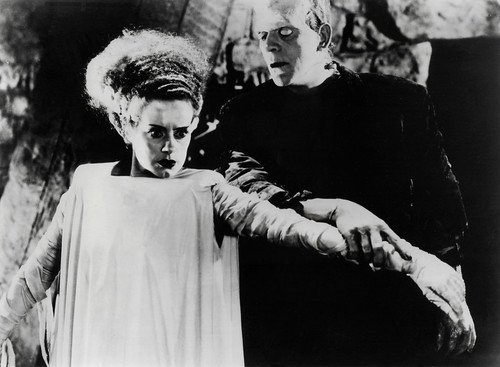
American postcard by American Postcard, no. 41. Elsa Lanchester in Bride of Frankenstein (James Whale, 1935).

American postcard by American Postcard, no. 36. Boris Karloff in Bride of Frankenstein (James Whale, 1935).
Creating a bride for the monster
In a castle on a stormy night, Mary Shelley (Elsa Lanchester), her husband Percy (Douglas Walton) and Lord Byron (Gavin Gordon) are sitting together. Byron regrets that the story of Frankenstein ended so abruptly. Mary then tells the sequel by the fireside.
It seems that the creature (Boris Karloff) created by Baron Frankenstein (Colin Clive) from body parts has died in a burning mill. But after the angry mob has dispersed and Baron Frankenstein, who was badly wounded in the fight with the monster, is brought home, the monster burrows out of the charred wood debris. Soon the villagers are once again mourning the dead and injured.
The first victims are the parents of Maria, the child killed in the previous film, who wanted to see for themselves that the monster was dead and died in the process. After the creature is initially captured and put in chains, it manages to escape and retreats deep into the woods, where it meets a blind hermit (Oliver Peters Heggie) who takes care of the creature. Under his peaceful care, the monster takes on more and more human traits, learns to speak and can appreciate the pleasures of cigars, wine and music.
One day, when some hunters come along who have lost their way, they recognise the monster and shoot it in their overzealousness. The situation escalates and the hermit's hut goes up in flames. The creature has to flee again and retreats to an abandoned crypt. There, the monster meets the insane Dr Praetorius (Ernest Thesiger), a former teacher of Frankenstein, who is also obsessed with the idea of creating life.
Praetorius secures the creature's support by promising to construct a mate for it. To do this, however, he needs the help of Baron Frankenstein, whom he forces to cooperate by blackmail. As additional leverage, he has Frankenstein's wife Elisabeth (Valerie Hobson) kidnapped. Together, Frankenstein and Praetorius succeed in creating a bride for the monster (Elsa Lanchester).

Vintage press photo. Elsa Lanchester and Colin Clive in Bride of Frankenstein (James Whale, 1935).

French postcard in the Collection Cinéma by Editions La Malibran, Paris, no. CA 53, 1989. Photo: Boris Karloff and Elsa Lanchester in Bride of Frankenstein (James Whale, 1935).
The only possible director for Bride of Frankenstein
Universal considered making a sequel to Frankenstein as early as its 1931 preview screenings, following which the film's original ending was changed to allow for Henry Frankenstein's survival. James Whale initially refused to direct Bride, believing he had "squeezed the idea dry" on the first film.
Kurt Neumann was originally scheduled to replace Whale but decided to film The Black Cat instead. Following the success of Whale's The Invisible Man, producer Carl Laemmle, Jr. realised that Whale was the only possible director for Bride of Frankenstein.
Although the plot of Bride of Frankenstein follows directly from the previous film, Frankenstein, there are many changes, such as the setting and the appearance of the castle.
Some roles also reappear, but are played by different actors: Dr Frankenstein's wife is played by Valerie Hobson instead of Mae Clarke, the mayor E. E. Clive instead of Lionel Belmore and the father of the little girl Maria (who was killed in the first film) Reginald Barlow instead of Michael Mark.
Baron Frankenstein, Henry's father, is not seen at all in this film but is only mentioned. Baron Frankenstein's actor Frederick Kerr had died in the meantime and the role was not recast. Bride of Frankenstein was released to critical and popular acclaim, although it encountered difficulties with some state and national censorship boards.

American postcard by Classico San Francisco, no. 233/007. Photo: Roman Freulich / Universal Pictures. Elsa Lanchester and Boris Karloff in The Bride of Frankenstein (James Whale, 1935).

Dutch press photo. Elsa Lanchester and Boris Karloff in Bride of Frankenstein (James Whale, 1935).
One of the greatest sequels ever made
A particularly successful punchline in Bride of Frankenstein is that the author of the Frankenstein novel, Mary Shelley, who can be seen as the narrator in the opening sequence, is played by the same actress (Elsa Lanchester) as Frankenstein's bride.
The meetings between Byron and the Shelleys are historical. Byron had left England in April 1816 after some scandals surrounding his person and rented Villa Diodati in Switzerland for a few months. Mary W. Shelley is said to have been inspired to write her novel in the gloomy atmosphere there.
Bride of Frankenstein is considered one of the best classic Universal horror films from the 1930s. Despite a few inconsistencies in the script, the plot sparkles with humour and ingenuity. The sets, especially Frankenstein's laboratory, are excellent and the actors - especially Boris Karloff and Ernest Thesiger - are in top form.
The presentation of Praetorius' miniaturised humans (homunculi), which he holds captive in jars, is a masterpiece of trickery for the time. Franz Waxman's leitmotif-influenced film music is also considered by some to be one of the first great horror film scores. Gilbert Kurland was nominated for an Oscar for Best Sound in 1936.
Since its release the film's reputation has grown, and it is now frequently considered one of the greatest sequels ever made; many fans and critics consider it to be an improvement on the original, and it has been hailed as James Whale's masterpiece. In 1998, it was selected by the Library of Congress for preservation in the United States National Film Registry, having been deemed "culturally, historically or aesthetically significant".

French postcard in the Entr'acte series by Editions aphodèle mâcon, no 001/09. Photo: Boris Karloff relaxing with a cigarette during an interval of the shooting of The Bride of Frankenstein (James Whale, 1935).

Vintage press photo. Elsa Lanchester in Bride of Frankenstein (James Whale, 1935).

Vintage press photo. Ian McKellen as James Whale and Rosalind Ayres as Elsa Lanchester in Gods and Monsters (Bill Condon, 1998).
Sources: Wikipedia (Dutch, German and English) and IMDb.
No comments:
Post a Comment